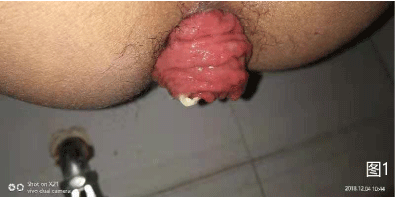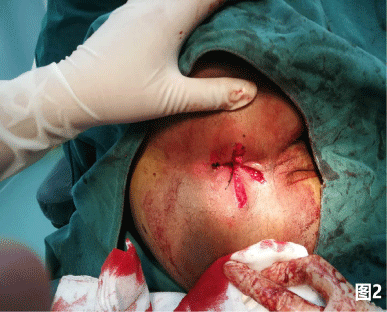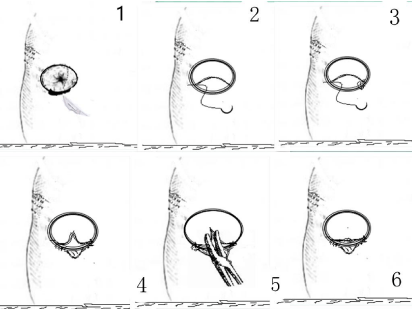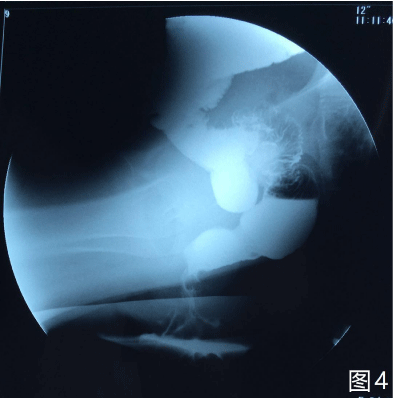
Special Article – Surgery Case Reports
Austin J Surg. 2019; 6(17): 1207.
1 Case Report of III Degree of Rectal Prolapse Treated by Anal Rectum Mucosa Longitudinal Partial Resection, Rectum Bottom Joint Fixation and Anal Contraction
Hou Y1*, Deng H1, Chen G2 and Ma C1
¹Proctology Department of Second Affiliated Hospital of Anhui University of Chinese Medicine, China
²Third Affiliated Hospital of Anhui University of Chinese Medicine, China
*Corresponding author: Yong Hou, Proctology Department of Second Affiliated Hospital of Anhui University of Chinese Medicine, Hefei, China
Received: July 26, 2019; Accepted: August 16, 2019; Published: August 23, 2019
Abstract
Give in December 2018, proctology department of the second affiliated hospital of anhui Chinese medicine university treated III degrees of rectal prolapse patients by anal rectum mucosa longitudinal joint part resection for the treatment of anal contraction. After 20 d, the complete recovery of incision: anal function restore, patient was discharged from hospital upon recovery; Follow-up 1 month after discharge, the patient had good anal function, regular defecation function, and no recurrence of rectal mucosal prolapse and defecation incontinence and other complications.
Keywords: Rectal prolapse; Transanal resection of the rectal mucosa; Anal constriction; Curative effect
Introduction
Rectal prolapse, also known as rectum prolapse, includes rectal mucosa prolapse and rectal full-thickness prolapse [1]. According to the pathological structure, the downward displacement and prolapse of rectal mucosa outside the anus is called rectal mucosa prolapse, and the whole-layer prolapse of the rectum refers to the downward displacement and prolapse of the anal canal, rectum and even part of sigmoid colon outside the anus [2]. Prolapse degree according to prolapse into the I (light), II (middle), III (heavy) degree, its III degrees in rectal prolapse of the rotor can be up to 8 to 10 cm above, extremely easy to emerge again after reset or reset is relatively difficult, needs surgery [3]. Nowadays, in the treatment of rectal prolapse surgery way is numerous, have different advantages and disadvantages and the clinical curative effect and operation, for the pain small, high curative effect, low cost of ideal treatment, director of our hospital Ma Chungeng combined with patient age, disease, economic basic conditions and the rich clinical experience, will the anal rectum mucosa longitudinal partial resection, rectum bottom fixation, anal contraction joint used in a patient with severe rectal prolapse, curative effect is satisfactory.
Case Information
The patient, hao mou, male, 18 years old, “repeated anal mass prolapse for more than 10 years, aggravating for 2 years.” The chief complaint was admitted to hospital on December 10, 2018. The patient had a conical red mass about 1cm long when defecating without obvious inducement 10 years ago. It was soft, and could be absorbed by herself after urination. There was no blood in the stool, no obvious pain and other discomfort, and not enough attention was paid to it. 4 years ago, the frequency of anal mass prolapse increased, and it was necessary to rely on the hand to return to the external force, and the prolapse length gradually increased. In the past 2 years, the patient could prolapse when squatting, coughing and standing for a long time, and the prolapse length was up to 8cm, accompanied by anal distension. The patient has been given oral administration and fumigation in other hospitals for many times, but no obvious curative effect has been obtained. Now for diagnosis and treatment, then came to our hospital for treatment.
Admission examination: patient of medium size; Specialist examination (squatting position): the anus was in the middle, and the rectum layer was prolapsed, cylindrical and pink, 6cm in diameter and 9cm in length. There was no obvious ulceration of the rectum mucosa, and the anal sphincter was significantly relaxed (Figure 1). No obvious abnormality was found in blood routine, stool routine, urine routine, coagulation routine, electrocardiogram and other auxiliary examinations.

Figure 1: Rectal prolapse before surgery. Rectum prolapse is about 8 cm in
the patient’s squat position.
Clinical diagnosis: TCM diagnosis: syndrome of distention of anus with dampness and heat; 2. Western medicine diagnosis: rectal prolapse (III degrees).
After hospitalization, the patient was treated with longitudinal resection of rectal mucosa, fixation of the lower rectum combined with anal constriction (Figures 2 and 3).

Figure 2: Outside the anus after surgery.

Figure 3: Operation diagram.
Transrectal fixation: after the effect of combined lumbar and epidural anesthesia, the patient was placed in the left recumbent position, and the anal skin was sutured to 3cm from the anal edge at points 3, 7, 9 and 11 respectively, to fully expose the lower rectum and dentate line. The prolapsed rectum was separated along the gap between the rectum and the surrounding connective tissue. The width of the prolapsed rectum was about 1cm up to 3cm on the tooth line. On both sides of the separated space, continuous suture was made with absorbable suture from top to bottom to fix the connective tissue between the rectum and the surrounding rectum. The rest of the points are as described above.
Rectum mucosa longitudinal resection: the surplus rectum mucosa was raised in the middle of the continuous suture.
Anal constriction: the surgical incision exposed after rectum and anal mucous membrane resection was sutured with absorbable suture from top to bottom, and the suture depth reached to the connective tissue outside the rectal wall. And forming it; Under anaesthesia, the anus passes through 2 fingers smoothly. Cover vaseline oil gauze and sterile gauze tower pressure dressing successively. Postoperative bowel movements were controlled for 3 days, and dressings were removed, local dressing was changed, and pressure fixation was applied once a day until anal function was restored.
Postoperative recovery: on the 5th day after the operation, the patient began to defecate once a day, with yellow soft shape and moderate amount, accompanied by a little blood in the stool, and no discomfort such as spontaneous outflow of stool, rectal prolapse and laborious defecation. On the 20th day after the operation, the incision was completely healed. Defecography (Figure 4) and anorectal pressure measurement (Figure 5 and Table 1) were performed to evaluate the anal function. The anal function recovered and the patient was discharged. Follow-up after discharge for 1 month showed that the patient had good anal function, normal defecation, and no discomfort such as spontaneous outflow of stool, rectal prolapse and laborious defecation.

Figure 4: Defecography was performed 3 weeks after surgery.

Figure 5: Rectal and anal reflex pressure mapping 3 weeks after rectal
prolapse. The value of Anal canal contraction reflex and Anal reflex diastolic
pressure were 5.4 and 0 Kpa, respectively. The value of Maximum systolic
pressure of anal canal and Maximum net pressure increase in the anal
cana were 14.1 and 10.2 Kpa, respectively. The longest contraction of the
anal canal is 44s. The value of Anal bowel diastolic pressure and Rectal
systolic pressure were 2.8 and 2.4 kpa, respectively. The value of Rectal
defecation diastolic pressure and Rectal systolic pressure were 2.8 and 2.4
kpa, respectively.The value of Anal Canal Rest Pressure and Rectal resting
pressure were 6.3 and -1.4 kpa, respectively.
The project name
test value
reference value
Anal canal contraction reflex
5.4(KPa)
=0
Anal reflex diastolic pressure
0.0(KPa)
>3
Maximum systolic pressure of anal canal
14.1(KPa)
>10
Maximum net pressure increase in the anal canal
10.2(KPa)
>6
The longest contraction of the anal canal
44s
>15
Anal bowel diastolic pressure
2.8(KPa)
<0
Rectal systolic pressure
2.4(KPa)
=0
Action correlation
Positive
Negative
Anal Canal Rest Pressure
6.3(KPa)
9-25
Rectal resting pressure
-1.4(KPa)
0.5-1.4
Functional length of anal canal
39mm
35-42
Sensory capacity threshold
30ml
10-30
Sustained sensory capacity
140ml
50-80
Maximum tolerance capacity
170ml
110-280
Table 1: Anorectal pressure was measured 3 weeks after rectal prolapse.
Rectal and anal reflex pressure mapping 3 weeks after rectal prolapse. The value of Anal canal contraction reflex and Anal reflex diastolic pressure were 5.4 and 0 Kpa, respectively. The value of Maximum systolic pressure of anal canal and Maximum net pressure increase in the anal cana were 14.1 and 10.2 Kpa, respectively. The longest contraction of the anal canal is 44s. The value of Anal bowel diastolic pressure and Rectal systolic pressure were 2.8 and 2.4 kpa, respectively. The value of Rectal defecation diastolic pressure and Rectal systolic pressure were 2.8 and 2.4 kpa, respectively. The value of Anal Canal Rest Pressure and Rectal resting pressure were 6.3 and -1.4 kpa, respectively.
Discussion
Rectal prolapse is mainly refers to because of internal pressure, anal canal, rectum mucosa caused by pelvic organizations such as weak, rectal full-thickness even part of the sigmoid colon downward displacement of emergence anus, happens in the elderly, the maternal and children, conservative treatment effect is not good, use surgery to treat more [4], but nowadays Chinese scholars advocated for the joint perineum abdomen or abdominal surgery. However, although the recurrence rate of trans abdominal surgery is low, it requires a high level of physical quality of patients, and it is traumatic, expensive and has many complications (such as sexual dysfunction) [5,6]. Although the perineal operation has less trauma and fewer complications, the recurrence rate is higher. To improve the therapeutic effect of severe rectal prolapse, Ma Chungeng director in this study, the anal rectum mucosa longitudinal partial resection, tight joint the anus and rectum bottom fixation technique used in the treatment of severe rectal prolapse. The curative effect was significant. After 20 days of treatment, the incision was completely healed and the symptoms disappeared. Objective auxiliary examination also confirmed the recovery of anal function, and the patient was discharged from hospital. Follow-up after discharge for 1 month showed that the patient had good anal function, normal defecation, and no discomfort such as spontaneous outflow of stool, rectal prolapse and laborious defecation. It can be seen that the combined application of longitudinal resection of anal mucosa, fixation of the lower rectum and anal constriction is a safe and ideal surgical method for the treatment of severe rectal prolapse. The longitudinal resection of anal and rectal mucosa is simple, less invasive, less complications, and does not require stapler, which not only costs less, but also avoids anastomotic fistula or pelvic infection. Secondly, assisted by the fixation of the lower end of the rectum, the rectum will be fixed in the connective tissue around the rectum, play the role of “fixation”; Furthermore, combined with anal tightening surgery, tightening the loose anal sphincter muscle, can effectively improve anal closure incomplete, restore anal function. The second two surgical methods can effectively prevent rectum prolapse.
To sum up, the anal rectum mucosa longitudinal partial resection, joint the anus and rectum bottom fixation deflation technique applied in severe rectal prolapse, less trauma, fewer complications, which can effectively improve the effect of treatment, restore the anus function, avoid recurrence, is an innovative, safe and ideal for the treatment of severe degree of rectal prolapse surgery way, higher clinical value, is worth further exploring large sample research.
References
- Iida Y, Honda K, Saitou H, Munemoto Y, Tanaka H. Modified Gant-Miwa- Thiersch procedure (mucosal plication with anal encircling) for rectal prolapse. Colorectal disease: the official journal of the Association of Coloproctology of Great Britain and Ireland. 2019.
- Taniguchi Haruka Isbell Lynne A Bidner Laura R. Complete rectal prolapse in wild anubis baboons (Papio anubis). J Med Primatol. 2019; 48: 179-181.
- Atallah Sam Dakermandji Marc Larach Sergio W. A new approach to rectal prolapse repair: Perineal proctectomy with TAMIS rectopexy and mesh fixation - video vignette. Colorectal Dis. 2019; 21: 609-610.
- Jallad K, Ridgeway B, Paraiso MFR, Gurland B, Unger CA. Long-Term Outcomes After Ventral Rectopexy With Sacrocolpo- or Hysteropexy for the Treatment of Concurrent Rectal and Pelvic Organ Prolapse. Female pelvic medicine & reconstructive surgery. 2018; 24: 336-340.
- Porwal Ashwin. TRRPCS: A New promising technique in Treatment of rectal prolapse - Video Vignette. Colorectal Dis. 2019; 21: 493.
- Malibary Nadim, Brigand Cecile. Strangulated recurrent rectal prolapse after a Delorme intervention, a case report. Clin Case Rep. 2019; 7: 770-772.